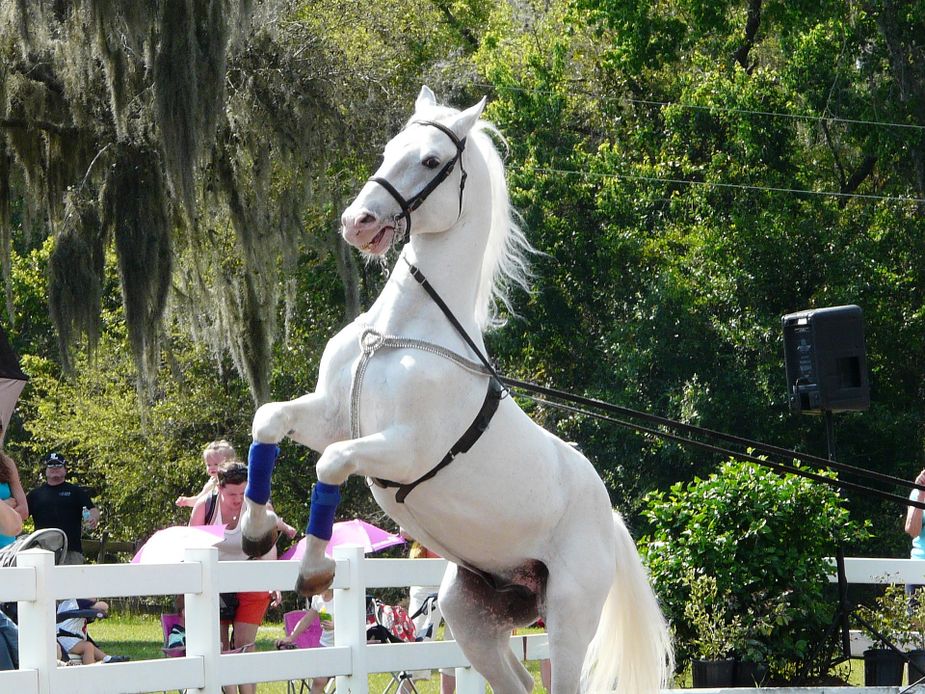Intern-al Affairs: The Lipizzans Part 1
Published July 2020
By Greg Elwell | 6 min read
Intern-al Affairs is the weekly blog for Oklahoma Today summer intern Haley Humphrey. Check back each week as she explores Oklahoma's past, present, and future. Read her previous “Intern-al Affairs” entries here:
Sharing the Light
In the Cards
Hidden Histories
Unforgettable Heights
Cedar Stories
More than six million Jews died in the Holocaust, according to the United State Holocaust Memorial Museum.
Among those who survived were Meyer and Manya Korenblit. Their son Michael Korenblit co-wrote “Until We Meet Again,” published in Oklahoma Today’s December 1996/January 1997 issue. I encourage you to read his parents’ powerful love story of perseverance.
When most people think of the Holocaust, they are reminded of the atrocities committed by Adolf Hitler and Nazi Germany. This is not a blog that relives those horrific acts. Instead, this is a remembrance of the lives lost and those who survived. That includes not only human lives, but the lives of a royal and uncommon breed of equine: the Lipizzaner.

A Lipizzaner rears up on its hind legs. Photo by Sylvia Blimes
These sturdy, emotionally intelligent horses were the Nazi’s quintessential war horse. They were sought after and stolen by Hitler and his party because of their obsession with breeding a pureblooded stallion.
Author Elizabeth Letts extensively researched and detailed the U.S. Army’s mission that rescued many Lipizzaners that were kidnapped by the Nazis during World War II in her 2016 book, The Perfect Horse.
According to the Lipizzan Association of North America, the breed owes its life to U.S. Army General George S. Patton for his intervening efforts, as well as his troops and the help of some brave Germans.
I read Letts’ account of this historically incredible journey at the beginning of the coronavirus pandemic. Not only did I not know about this rescue mission, I had never heard of Lipizzans before her book. I was even more astonished to find that Oklahoma played a role in the story.
In May of 1949, the trusting, powerful Lipizzan Witez II, who had seen war’s violence rage, arrived at Fort Reno to find his forever home. He and other war stallions were to be auctioned off at what was once one of the U.S. Army’s remount stations. Beginning in 1908, Fort Reno was occupied by various cavalry commanders and was where many horses and mules were trained for both world wars, the Korean War, and more.
According to Letts, after Witez II’s arrival, the Department of Agriculture closed the last vestiges of the Army’s remount programs and sold the remaining horses.
A rancher from California traveled to Fort Reno in May to purchase Witez II for $8,100 (about $85,000 today). The 2nd Cavalry’s beloved horse peacefully lived out the rest of his life with Earle Hurlbutt in Calabasas.
“That spring day in Oklahoma, the curse was broken at last,” Letts wrote. “For the first time in his life, Witez would have a home of his own.”
My fascination rising, I started conducting research of my own about Lipizzans, as I’m sure you have already guessed, in Oklahoma Today’s 1997 archives. I could not find anything throughout my birth year noting the Lipizzan breed, or any history about them travelling through Oklahoma.
However, I did find other issues in the ’70s that included information about Arabians, a fine horse breed that was used to sire Lipizzan centuries ago. In the 1800s, after original Spanish horses could no longer be used to sire Lipizzan, Arabians were used to fulfill the lines. One article in Oklahoma Today’s 1972 winter issue stated Arabians are the “most useful in the history of mankind.”
Lipizzan were bred exclusively during the Hapsburg Monarchy for war in the 1500s. Hapsburg’s rule extended over Spain and Austria, and in 1580 at Lippiza, which is near the Adriatic Sea, is where Lipizzans got their name. Europeans refer to the breed as Lipizzaner and Americans call them Lipizzan.
Lipizzans are born brown, black-brown or mouse-grey and mature to grey. But between ages six and ten, their coats produces the spectacular white they are most known for.
Much of the Lipizzans’ history is known because of the Spanish Riding School in Vienna, Austria. The school, with the grace and commitment of Alois Podhajsky, made the art of dressage well-respected and admired. The devoted relationship between rider and stallion drifted to America in the 1970s with the World Famous Lipizzaner Stallions. In fact, these performances captivated audiences in Tulsa in 2001.
In part two of this blog, we’ll talk about where these magnificent equines are today.
"The Candywoman Can (Sort Of)"
"Weekly Events Calendar July 20-26, 2020"
You May Like
Weekly Events Calendar: June 30-July 6, 2025
This week in Oklahoma: A huckleberry hub in Jay; free train rides in Oklahoma City; and music legends in El Reno.
This week in Oklahoma: A huckleberry hub in Jay; free train rides in Oklahoma City; and music legends in El Reno.
Oklahoma Today Podcast: June 30, 2025
OKC! OKC! OKC! The Thunder won it all, folks! This week's special episode is presented from the teams NBA Championship Parade from downto...
OKC! OKC! OKC! The Thunder won it all, folks! This week's special episode is presented from the teams NBA Championship Parade from downtown Oklahoma City.
A Pink Paradise
Any book store is a good time, but this one's got a specialty soda bar.
Any book store is a good time, but this one's got a specialty soda bar.










